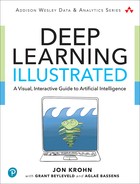Book Description
"The authors' clear visual style provides a comprehensive look at what's currently possible with artificial neural networks as well as a glimpse of the magic that's to come."
—Tim Urban, author of Wait But Why
Fully Practical, Insightful Guide to Modern Deep Learning
Deep learning is transforming software, facilitating powerful new artificial intelligence capabilities, and driving unprecedented algorithm performance. Deep Learning Illustrated is uniquely intuitive and offers a complete introduction to the discipline's techniques. Packed with full-color figures and easy-to-follow code, it sweeps away the complexity of building deep learning models, making the subject approachable and fun to learn.
World-class instructor and practitioner Jon Krohn—with visionary content from Grant Beyleveld and beautiful illustrations by Aglaé Bassens—presents straightforward analogies to explain what deep learning is, why it has become so popular, and how it relates to other machine learning approaches. Krohn has created a practical reference and tutorial for developers, data scientists, researchers, analysts, and students who want to start applying it. He illuminates theory with hands-on Python code in accompanying Jupyter notebooks. To help you progress quickly, he focuses on the versatile deep learning library Keras to nimbly construct efficient TensorFlow models; PyTorch, the leading alternative library, is also covered.
You'll gain a pragmatic understanding of all major deep learning approaches and their uses in applications ranging from machine vision and natural language processing to image generation and game-playing algorithms.
- Discover what makes deep learning systems unique, and the implications for practitioners
- Explore new tools that make deep learning models easier to build, use, and improve
- Master essential theory: artificial neurons, training, optimization, convolutional nets, recurrent nets, generative adversarial networks (GANs), deep reinforcement learning, and more
- Walk through building interactive deep learning applications, and move forward with your own artificial intelligence projects
Register your book for convenient access to downloads, updates, and/or corrections as they become available. See inside book for details.
